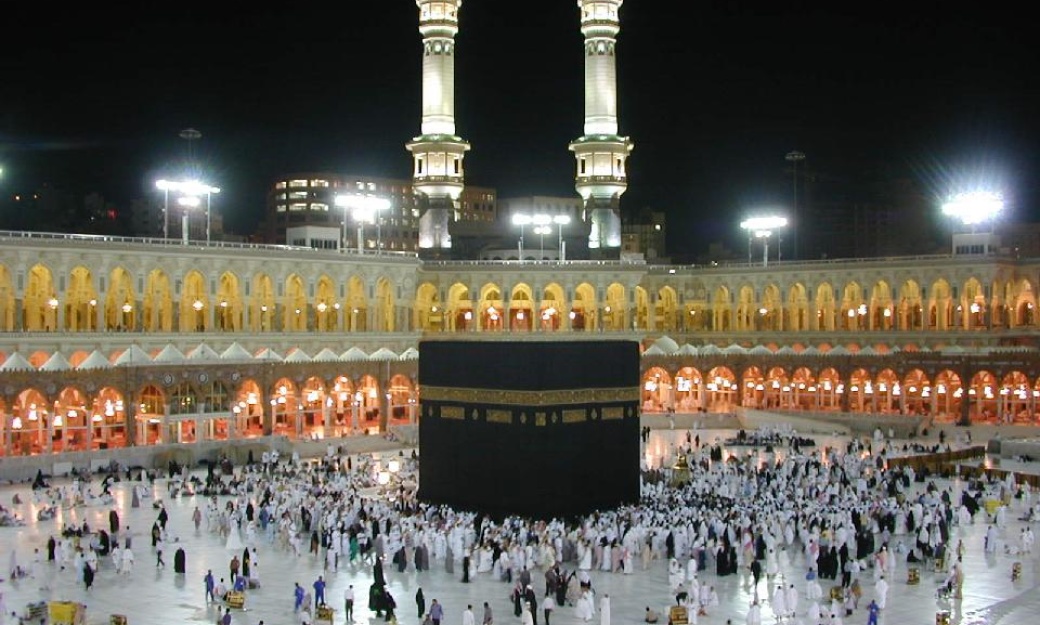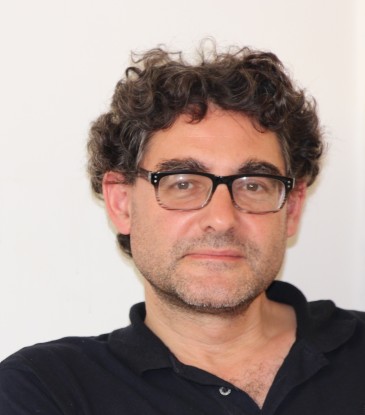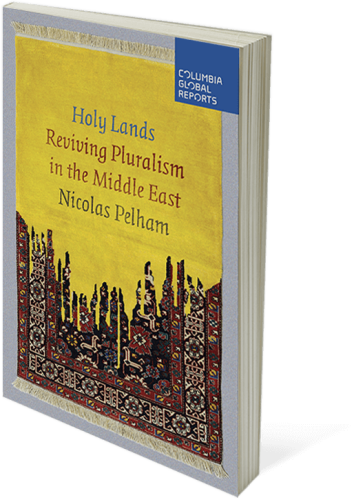News From the Middle East Is Not All Bad—What Can Go Right

In Holy Lands, longtime Middle East journalist Nicolas Pelham presents a strikingly original and startlingly optimistic look at the region. Sure, there's plenty of bad news and cruelty to report on, but Pelham also tells the story of those who are embracing diversity and trying to live side by side with all types of people, in the region's venerable spirit of pluralism. Pelham talks to us about some hopeful solutions in this interview.
 As someone who knows the Middle East well and cares deeply about its future, what are some of the good things happening there that Westerners may not know about?
As someone who knows the Middle East well and cares deeply about its future, what are some of the good things happening there that Westerners may not know about?
While governments across the region are erecting concrete walls segregating their populations along largely confessional lines, many of their subjects are struggling to leapfrog the new contours and maintain cross-community contacts. In Iraq and Syria, Sunnis and Shias continue to intermarry in large numbers. Jeddah’s Chamber of Commerce organizes an annual festival that features a model town of the old coastal city when it still boasted Sufi shrines and lodges, and when women wore colorful costumes, not the black abaya, or shroud, imported from the desert. Students in Baghdad organize peace festivals on the banks of the Tigris, replete with open-air concerts and female singers, as if car bombs belonged to the past. The clerics in Najaf’s Imam Ali shrine host an annual book fair, featuring erotic poetry and anti-religious literature that bygone fanatics might have condemned as heresy. And each Friday in Tel Aviv, scores of Israelis go on tours organized by Zochrot, a group set up by Israeli Palestinians and Jews, uncovering a past before the 1948 war when Jaffa’s Palestinian cinemas ran Hebrew films, and it was natural for Jews and Muslims to share the same space. Like the Hammar Marshes near Basra, which are slowly recovering after Saddam Hussein drained them dry, the region’s battered pluralism might yet revive.
You first began reporting on the Middle East in 1992 as a reporter in Cairo for the Middle East Times. What have been the biggest changes and are you surprised by them?
Back in the 1990 the idea of the nation still held traction. The region’s people fought wars for national boundaries. Shia Iraqis fought Shia Iranians to defend their country. Saudi generals fought Iraq’s generals, both of them Sunni, in the struggle for Kuwait. Arab nationalists still spoke of the Arab-Israeli conflict, rather than abandon Palestinians to their fate. A generation on, the battle lines have changed fundamentally. Confessional loyalties have supplanted national ones. Men fight and die for their sect, not their country. Arab and Persian Shias have joined forces, as have Turkish and Arab Sunnis. Religious leaders, like the grand ayatollahs in Najaf or Maronite patriarchs in Lebanon, wield more influence than heads of state. In much of the region, the heads of religious movements have captured power and redrawn the borders along sectarian lines.
The transition was gradual. In the 1990s, national leaders sought to resist the pull of transnational religious movements by adopting their ideas if not their cadres. Autocrats like Gaddafi, Mubarak, and Saddam Hussein, all draped themselves in the cloth of religiosity in an attempt to shore up their legitimacy. They delegated management of the social sphere to conservatives on condition that the latter refrained from interfering in security and foreign policy.
In the process they sowed the seeds of religious movements that ultimately uprooted them. The conservatives propagated their social mores in society at large, until in 2011 the people turned on their leaders. Many had predicted that national-religious movements would rise to power across the region, but few had anticipated the extreme confessional bent they would take.
With the benefit of hindsight, though, it seems more explicable. For centuries, as Holy Lands seeks to depict, the Middle East’s rulers—caliphs, sultans, and shahs—had governed by devolving power to the communal leaders of their millets, or sects. As national borders began to dissolve and national governments failed to meet the needs of their populations, these old coping mechanisms resurfaced to offer their faithful safety, protection and what welfare they could. They became the natural building blocs for organizing society once again.
 To write Holy Lands, you traveled throughout the region and interviewed figures from all political and religious backgrounds. Tell us about a few of the most important interviews, including those with Abu Qatada and Haider al-Abadi. How did you get them and what did you learn?
To write Holy Lands, you traveled throughout the region and interviewed figures from all political and religious backgrounds. Tell us about a few of the most important interviews, including those with Abu Qatada and Haider al-Abadi. How did you get them and what did you learn?
One of the benefits of devoting decades to a single region as a journalist is that you grow with your cast of characters. A cub reporter I befriended in Morocco in the 1990s is now the kingdom’s culture minister. A young Iraqi economist I knew in Baghdad now serves as a senior European ambassador and generously opens doors in a historically suspicious country. And Haider al-Abadi, who used to fix the lifts at the BBC World Service where I worked in London, is now Iraq’s prime minister. But connections only go so far. One of the peculiarities of the region’s cities is that despite their meteoric population growth, they still retain the character of a village. Cities like Arish in Sinai are divided up by tribe. Once you’ve found the right neighborhood, everybody knows everybody. I’ve found preachers wanted on government terror lists and the hideaway homes of Moroccan prime ministers by asking at the local grocers. And of course social media remains invaluable. Within a couple of days an activist in Gaza secured a meeting with Mohammed Dahlan, the security advisor to the Emirates’ de facto ruler and perhaps the most prominent Palestinian in exile.
What have I learned? Perhaps that people, whatever their job titles, never really escape their backgrounds. The most austere jihadi in public reverts to being a hillbilly in private. Much of the evening I spent with Abu Qatada, a veteran jihadi preacher, in his comfortable Amman bungalow, was consumed by him exchanging bawdy jokes with young fighters on R&R from Iraq, and telling innuendos about the cat he spent the evening pawing. Iraq’s Abadi bears the title of commander-in-chief and holds court in Saddam Hussein’s grandiose republican palace in Baghdad, but he has never held a security role, and what he really craves is return to his modest home—in Keradeh, a cosmopolitan suburb in Baghdad—which he renovated before becoming prime minister, and drink mint tea in his garden.
You write news articles about the violence and chaos in the Middle East on a weekly basis. Yet, you’ve written a book that is surprisingly optimistic about the future of the region. How did you come to that conclusion?
Set against the tragedies, the displays of humanity are frequently humbling. A father rendered homeless in one of Israel’s offensives insisted on serving me dinner in the ruins of his home in the village of Khuza’a in southern Gaza. He had lost his wife, a son, and his property, and his son had just drowned in the Mediterranean trying to make it to Europe. Pride in Gaza’s tradition of hospitality was all he had left. Artists maimed by suicide bombers in Keradeh’s cafes return to the bomb-sites first for vigils a week after the attack, then to help repair the cafes and then to spend their evenings drinking coffee, because anything else would be to surrender to fear. A student in Riyadh whose father raped her petitions the courts to release her from her father’s power to determine whether she can travel, work, study, or open a bank account—and wins. For all the killing, the region’s resilience and vitality lives on. If I didn’t report their struggle I’d be failing all those who believe that by telling me their story they come one step closer to building a better world.
Moreover, though of no comfort to those who are suffering now, in both numbers and range, the killing and destruction are a mere fraction of that that scarred Europe in its world wars. And for all their horror, the past five years are but a blip in a region that gave birth to civilization, the West’s dominant scriptures, and even models of pluralism, which for centuries far surpassed anything Christian Europe offered. The reason there are so many bickering indigenous minorities in the region is because unlike European Christendom, Islam preserved and protected religions that predated its founding. In contrast to today’s refugee influx, the Middle East was a place people fled to, not from. For centuries it was La Convivencia, the place where Europe’s outcasts from Kings to Jewish exiles fled for asylum.
What are some practical steps that leaders in the Middle East can take to make their countries more pluralistic, to create the “shared space” that you talk about in the book? Are there some places where this is starting to happen?
Too often over the past century, the region’s leaders have looked outside for guidance on how to manage their societies, when they might have done better to look within. They have experimented with Western ideologies of nationalism, socialism, capitalism and secularism. But they ignored the region’s proven model for addressing sectarianism, or what I call milletism—dependence on the sect, or millet. Rather than seeking to vanquish rival sects, sultans governed their multi-confessional subjects by delegating power to their communal leaders. Where from Iraq to Israel, modern leaders seek to confine opposing sects inside gated ghettoes and behind concrete barriers, Ottoman sultans gave millet leaders license to extend their authority across their realm. The Patriarch, the chief rabbi and the grand mufti presided over holy communities spanning the empire, not boxed holy lands. Unlike the current quarters, the Ottoman city of Jerusalem was open to believers: “There is no God but God, and Abraham is the Friend of God” was inscribed at its entrance, welcoming all spiritual descendants of Abraham. Rather than lead and protect one faith, the sultans led them all. If today’s leaders followed suit, the region might regain the equilibrium it has lost.
Remarkably, in a few places it is already happening. In the Iraqi city of Najaf, the seat of the Shia clerical establishment, the ayatollahs are erecting an inter-faith college, and inviting lecturers from other faiths to teach Sunni, Yazidi, Christian, Mandaean, and Jewish texts. They have called it the al-Balaghi Interfaith Academy after a mid-20th century Ayatollah who learnt Hebrew and Talmud at the hands of the rabbis at nearby shrine of Prophet Ezekiel. In contrast to the guardians of other holy places in Iran and Saudi Arabia that ban the entry of non-Muslims, they have overturned centuries of lore and opened the shrine of Imam Ali to all.
For so long, the West has pushed for more democracy, secularism, and modernism in the Middle East. Has that approach made things worse and what would you say to Western leaders pushing that agenda?
Where the Ottomans patronized holy communities, Western policy-makers created holy lands. They sought to turn faith communities into nation-states, granting them sovereignty within defined parcels of land. Sometimes it feels as if little has changed since the Balfour Declaration. Syria successfully resisted French efforts to quarter it into sectarian states in the 1920s, but almost a century on—after massive population movement, and with its governing structures exhausted and debilitated by civil war—it might yet succumb. Federalism—a form of partial confessional partition—is back on the table in the Geneva talks. In Iraq, democracy was a euphemism for establishing majority sectarian rule, empowering Shias and stripping Sunnis of their leadership. In the process, western powers have sowed a century of sectarian grievance and unraveled much of the region’s confessional diversity.
Holy Lands advocates the revival of mechanisms that predated the colonial age. It argues that Ottoman milletocracy delivered stability, preserved diversity, and ensured open borders for trade—all staples of good governance sorely lacking today. Policy-makers seeking to repair a badly damaged region would do better to examine what mechanisms worked in the past than seek to apply models fashioned for societies abroad. This does not mean forsaking universal values, but rather couching them in local terms. As one Saudi prince told me, it was easier to promote women’s rights by citing local precedent than foreign practice. In answer to traditionalists who decreed against women driving, playing music in public, or working as saleswomen, he presented archive footage from the 1930s showing women riding on camels, playing music at Mecca’s gates, and selling their wares in the street.
Tell us what you think of the current state of U.S-Israeli relations and especially the relationship—or lack thereof—between Obama and Netanyahu. What advice would you give President Obama?
You can understand Obama’s frustration. From afar the conflict between Israelis and Palestinians looks one of the region’s easiest to resolve. If only both stubborn peoples would accept their designated plots of land, one of the most grueling and cruel of the Mideast’s wars could be resolved. The problem is that many on both sides are not yet convinced that partition is good for them. Palestinians have seen their horizons shrink drastically since the Oslo Accords, and fear they would narrow even further. Before Oslo, Palestinians in the West Bank could still head to the beach at the weekend in Haifa or Gaza. Now they can tantalizing see the sea over the top of Israel’s security barrier, but together with Jerusalem, Islam’s holiest city, it remains out of reach. For their part, many Jews are comfortable retaining the bulk of the land and keeping a subject powerless Palestinian population captive inside gated enclaves. If Obama really wants to push for two states, the best thing he could say would be, “Hey, you’ve torpedoed umpteen proposals for two states, let’s make everyone happy with one.” And then add one caveat—equal rights. Netanyahu would be at the White House with concrete proposals for partition tomorrow.
Short of such an initiative, he would do well to pick up from where George Bush left off. One of his first mistakes was to dismiss all that his predecessor had done. George Bush hashed Iraq, but he made greater progress than Obama on dealing with Israel and Palestine. He drew up a roadmap for ending Israel’s occupation, got Israel’s settlers and at least briefly its army out of Gaza, and sealed the withdrawal with a trade agreement which provide Gaza with access and movement to Israel, Egypt and the West Bank. By abandoning the agreement, Obama gave Israel a free hand to impose its siege and bifurcate Palestine into its West Bank and Gaza halves. Upholding the old agreements would release the Palestinians in Gaza from the stranglehold to which they have been subject for a decade, and promote security for Israelis and Palestinians alike, since governments engaged in trade have a stake in maintaining security not undermining it. Rather than focus on partition agreements that only build barriers higher, access and movement arrangements have the potential to bring them down incrementally and reduce sectarian bigotry and fear. The consequences for the intractable problem of Palestinian refugees, free trade, and an end to boycotts could be seismic.
Nicolas Pelham, author of Holy Lands: Reviving Pluralism in the Middle East, is The Economist's correspondent in Jerusalem and writes on Arab affairs for The New York Review of Books. His previous books are A New Muslim Order (2008) and A History of the Middle East (2010) with Peter Mansfield.
